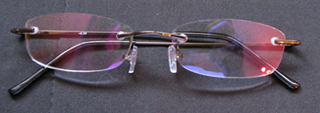 |
|||||||
|
|||||||
Selecting Lenses for Computer GlassesRule of ThumbBy trying out a pair of drug store reading glasses you can come close to what is required for computer use. IF a pair of +1.25 Diopter glasses work with you for reading a book (12 to 16” away) then choose +.75 diopters for computer work! IF a pair of +1.00 diopter work for reading a book, then choose +.50 Diopters for viewing a computer monitor! WARNING: IF ASTIGMATISM IS HIGHER THAN .5 diopters YOU NEED CUSTOM LENSES. DefinitionsPD: Interpupillary Distance. The distance between the pupils of your eyes measured in Millimeters. Average man is about 62mm. A friend can measure with a ruler marked in millimeters or do it while looking in a mirror. You should focus at a distance not close up.(PD is required to properly center lenses over pupils)OD: Ocular Dexter or Right Eye OS: Ocular Sinister or Left Eye Diopter: A measurement of the refractive power of a lens. Sphere: On your prescription this measures the degree of correction in plus or minus diopters Cylinder: This refers to the degree of astigmatism in your eye. It has a diopter strength AND a number of degrees to show the location of the astigmatism in the visual field. WARNING: IF Cylinder is higher than .5 diopters you should have custom lenses made for you! “ADD”: to prescriptions refers to the strength in Diopters that has to be added (on top of your existing prescription in order to permit viewing things close up! Always a + or positive diopter number. (Usually calculated at 16” for reading) Myopic: Nearsighted, needs glasses with a – minus Rx to see well at a distance Hyperopic: Farsighted, sees well at distance but requires + positive Rx to see things close up. Presbyopic: From around 35 years of age the eye starts to loose it’s ability to focus on close up objects. (Slower for myopic individuals) You may still see well at a distance but require + positive Rx lenses (reading glasses) for close up work. Golden RuleToo strong a positive diopter adjustment will not permit clear focus at the distance of a computer monitor but too weak will not give as much relief from eyefatigue.Conclusion: It is better to have too small a positive diopter correction than too strong since you can always move back a little further (usually only inches)! Since these lenses are made in .25 Diopter increments you should always choose the closest LOWER strength of lens. 
|
|||||||
 |
 Top
Top